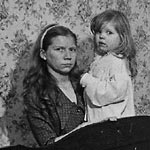
Introduction
Migration as 'Movement'
Travelling as a Way of life
Homelessness and Home
Introduction
Migration is embedded in Birmingham's life to such an extent that it could be said that it is a determining factor in the city's way of life. It has played an important part in the flux and change that has been vital to the transformation of the city over the centuries. Since the decades of post-war migration there has been further movement of people into the city from Eastern Europe, the Middle East and Africa for both political and economic reasons. These new arrivals are both encountering and changing the life of the city once again. The continual movement of people in and out of the city as they make regional, national and international journeys indicates that migration is a never-ending process and is ironically the one permanent aspect of its life.
<return to top>
Migration as 'Movement'
The significance of migration in Birmingham is not simply limited to the arrival of people from 'overseas.' Archive sources show us that migration, in the broader sense of the movement of people from one place to another, also requires us to think about other communities and groups whose lives are intimately bound to the concepts of movement, displacement and the creation of a stable home. Like the migrants from Ireland and the Commonwealth, and more recently refugees from Eastern Europe, the Middle East and Africa, both travelling communities and homeless people have been subjects and agents of social justice claims as they have tried to secure a home for themselves in Birmingham. What these different migration histories reveal is that movement and transition form part of the city's permanent condition of existence.
<return to top>
Travelling as a Way of Life
"Moving… I don't think we shall ever stop them from moving. Moving, ever moving. Wandering, you know. Wayside, roadside, camps. All the time. But there in the background, in the mind, you know, they want to rest. They want to stay, hoping that the police won't come along and turn them away… and yet they're still of that wandering nature. But you see that more so in March and October. That is the moving time of gypsies, moving months… March and October, you get that fidgety, itchy feeling, you want to get going. Put the wheels on the caravan, get going." [MS 4000 2/97/1/2/2 p46]
Nomadism has been a way of life in many cultures for thousands of years. Whilst some people have travelled for subsistence needs according to the seasonal availability of plants and animals, the movement of others in industrialised nations such as Britain has been determined by their ability to trade. In Britain the majority of travellers are the Roma (often referred to as Romanies or Gypsies) and Irish travellers, and there are also Kalé from North Wales and Scottish travellers. Whilst many continue to maintain a semi-nomadic lifestyle and live in caravans, others have chosen to settle more permanently in houses.
In Britain travelling communities have a long history which dates from the 16th century. The earliest official record for travellers in Birmingham appears to be an entry in the register of Aston Parish Church (St Peter and St Paul) which records the baptism of a child born to a 'travellinge woman' on 12th May 1591 (Rudge, 2003.) Slightly later, the register of St John's Church Deritend dated 4th January 1705/6 refers to another baptism: "Patience, daughter of Charles Dickson by Elizabeth his wife, was baptized, of the parish of Eaton, Warwickshire, being travelling people" [EP 1/2/1/1].
The dependence of travelling communities on the oral tradition for communication means that, until relatively recently, tracing their stories been problematic. Records referring to travelling communities have tended to present them from the 'outside' and have silenced the voices of the people themselves. Archival sources such as the sound recordings of conversations and folk songs collected by Charles Parker for the groundbreaking Radio Ballad 'The Travelling People' in 1964 are important sources of first-hand evidence of travelling life which go some way in addressing this imbalance. You may read more on the subject in the section on 'The Travelling Life.'
<return to top>
Homelessness and Home
Homelessness, which describes the situation of people without a supportive and secure place to live, affects many thousands of people both locally and nationally. Whilst it is commonly assumed that homelessness is synonymous with 'rooflessness' and the situation of rough sleepers, most homeless people do not live on the streets but reside in hostels, bed and breakfasts or with friends and family in temporary and insecure accommodation. According to the homeless charity Crisis, a home is more than a physical shelter and provides "roots, identity, security, a sense of belonging and a place of emotional well-being" (Crisis, 2006).
The issue of homelessness, like nomadism, has a long history in Britain. Homeless people have been regarded by society as pariahs - statutes enacted as far back as the 15th century to deal with vagrancy included branding with irons, beating, imprisonment and enslavement amongst the punitive measures taken against them. The Poor Law, introduced by the State in 1601 to provide certain 'relief' from poverty, categorised and criminalised vagrants and beggars - deemed the 'undeserving poor' in need of corrective action - and subjected them to centuries of harsh treatment. The negative attitudes that continue to be expressed towards homeless people today are part of the legacy of this history.
Whilst the sources in the City Archives are limited due to the lack of first-hand accounts by homeless people themselves, they do reveal an insight into the experiences of homeless people and their representation. Sources include reports and newsletters produced by groups that campaigned for change in Government and local authority provision for homeless people. There are also photographic representations of homeless people that provide a visible testament to the conditions in which people have lived and force us to rethink the stereotypes that exist about homelessness.
<return to top>
Author: Sarah Dar
Main Image: Photograph by Rob Moore, from the archive of Derek Bishton and Ten.8
[City Archives: MS 2478/A/10/24]
<return to top>
|
|

Travelling
Life

Homelessness
|